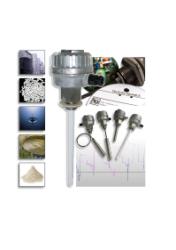Telstor “Advance” - Capacitance Level Probe update
16 April 2010
Low cost head-mounting 4 to 20mA transmitter electronics for use with a Telstor capacitance level probe; non-interactive span and zero for easy calibration.
 Lee-Dickens, UK instrumentation specialists, has released the 80 Series Telstor Advance capacitance based level transmitter, a new two-wire 4 to 20mA device for continuous level measurement over the range 160mm to 25m.
Lee-Dickens, UK instrumentation specialists, has released the 80 Series Telstor Advance capacitance based level transmitter, a new two-wire 4 to 20mA device for continuous level measurement over the range 160mm to 25m.
The new 80 Series Telstor Advance is non-processor-based and therefore very reliable. Formerly, the probe had a separate external box for electronics. The new “Advance” electronics come as a plug-in module that fits within the head itself and does away with the Controller Box. This simplifies installation and cuts costs.
The Telstor Advance is backwardly-compatible with existing installed 80 Series probes, making it ideal for replacement or upgrading. Furthermore, the Telstor Advance offers non-interactive span and zero calibration. Standard recalibration techniques often require tanks to be emptied four of five times, which is costly and not environmentally-friendly.
The Telstor device only requires the tank to be filled once to calibrate the probe, reducing commissioning costs by 40%. The 80 Series family is capacitance-based and aimed at applications ranging from solids handling to process control. 80 Series devices are already well known for their dependability, robustness and cost-effectiveness. They also offer considerable customisation potential in terms of materials, length and size.
Whilst suitable for all liquids, the concentric version of the probe is especially accurate for foams, hydrocarbon liquids gases and other liquids of a low di-electric constant. Various electrodes are available, ranging from rigid versions made from stainless steel and, depending on the application, these can be covered, or part covered, with PTFE or PVDF.
Flexible rope electrodes can be used in systems where the electrode length exceeds 4.0m and in applications involving solid material which could damage a rigid electrode. The operating temperature of the sensor electronics is -10°C to +50°C. If required, the probe can be supplied with an up to 300mm stand-off to keep high temperatures away from the head mounted electronics.
Other Press Releases By This Company
- 05/10/2022 - Rolls-Royce Bronze Award
- 05/10/2022 - Airways New Zealand purchase Midi-10 RTUs to monitor Air Traffic Management systems.
- 04/10/2022 - New small-sized low-power RTU launched
- 04/10/2022 - New RTU Offering PLC-style Automated Controls
- 07/10/2019 - Whittlesey & District IDB invest in Sitewatch Remote Control and Monitoring
- 07/10/2019 - South Holland Internal Drainage Board (SHIDB) Telemetry System
- 05/11/2013 - Lee-Dickens Namur NE43 Trip Amplifiers Achieves SIL2 Rating
- 05/11/2013 - Lee-Dickens Instrumentation Achieves SIL2 Rating
- 22/10/2008 - Telstor Launch 'Advance'




